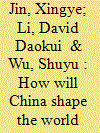| Srl | Item |
| 1 |
ID:
180636


|
|
|
|
|
| Summary/Abstract |
In this paper, we analyze the role of macroeconomic management in developing countries’ economic take-off and structural transformation. We argue that developing countries face three leading challenges: market immaturity, lack of a developed financial system, and severe information asymmetry between international investors and domestic players. If not properly dealt with, these challenges can lead to macroeconomic volatility and fragility in economic development. Therefore, the government must intervene appropriately to address these challenges. By analyzing China's experiences in the era of reform and opening up (1978–2018), we find three important lessons: (i) It is important for the government to facilitate the entry and exit of enterprises in macroeconomic cycles, relying not only on market signals but also on administrative orders and measures of institutional reform; (ii) Financial reforms should be implemented in order to promote financial deepening and channel savings into investment; and (iii) The government should carefully manage capital account liberalization in order to preserve financial stability while promoting foreign investment, international trade, and industrial upgrading.
|
|
|
|
|
|
|
|
|
|
|
|
|
|
|
|
| 2 |
ID:
147628


|
|
|
|
|
| Summary/Abstract |
We will provide an outlook for China's role in the world economy over the coming decades, an exercise which would not be possible without an analysis of the prospects for China's continued economic growth. Based on international and historical comparisons, we argue that today's China meets all three key conditions for continued economic growth, including a stable government that is supportive of a market economy; high and increasing quality of human capital, and openness to developed economies. Dependent on China's continued growth, we explore how China will impact many other economies through trade and investment, creating winners and losers in the world economy. Moreover, we argue that China will become a more active player in changing global economic governance not only through participating in reforms of existing institutions but also by leading efforts to establish new ones.
|
|
|
|
|
|
|
|
|
|
|
|
|
|
|
|
| 3 |
ID:
167889


|
|
|
|
|
| Summary/Abstract |
Since the end of 2015, the US Federal Reserve has raised its benchmark interest rate nine times. This has led to capital outflows and asset depreciation in many emerging market economies. The present paper examines the factors that determine the financial volatility of emerging markets in the face of external shocks. By calculating the capital flows of 30 emerging markets from 1990 to 2018 and conducting panel regression, this paper finds that countries with good infrastructure facilities, a sound banking system and high economic growth have significantly lower cross‐border financial risks. An implication from the empirical analysis is that emerging countries would benefit greatly by actively taking part in the Belt and Road Initiative. The framework of the Belt and Road Initiative allows emerging countries better access to China's massive consumer market to promote trade and long‐term growth. Their quality of infrastructure can be improved through cooperation with China in infrastructure investment. They can also jointly establish a cooperative financial framework to enhance regional financial stability. These strategies will reduce systematic financial risks and counteract the negative impacts of US interest rate hikes.
|
|
|
|
|
|
|
|
|
|
|
|
|
|
|
|